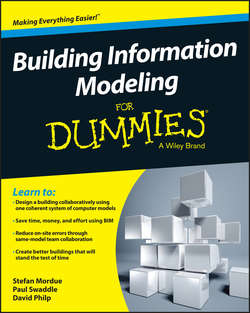Читать книгу Building Information Modeling For Dummies - Swaddle Paul - Страница 9
На сайте Литреса книга снята с продажи.
Part I
Getting Started with Building Information Modeling
Chapter 1
Defining Building Information Modeling (BIM)
Measuring the Real-World Benefits of BIM
ОглавлениеSay that you’ve won over some key decision makers in your organization and they need you to produce a business case for BIM. As part of your business case, you need to justify the capital outlay, which relates to the money your organization spends to implement BIM. You also must consider upheaval that will come from new technology, new team structures, and even new staff. Not only that, but you probably have to demonstrate return on investment (ROI) as quickly as possible.
Your boss is going to want to know how much BIM is going to cost. BIM needs to generate savings and efficiencies that make it worthwhile. In Chapter 15, we pass on some solid examples of BIM benefits that aren’t just aims for the future but exist in the real world today, including the following:
✔ Better information: Because you’re going to be working with digital data and methodologies in the office or on the job site, the accuracy and currency of your information will improve, including precise quantity takeoff and the ability to set the site out such as the asset’s position, levels, and alignment from the model.
Not only that, digital information also allows you to test and validate the data far more quickly than with traditional processes. As the model evolves, instant awareness of the impact of changes at any point in the project leads to better assessment and rapid decision-making.
✔ Data exchange across the project timeline: BIM can help you to avoid data loss over the course of a project. At many points of information exchange, you can use project data more collaboratively with little waste or duplicated effort.
What’s even more important is that multiple roles and disciplines can use the same data on the project, including cooperative working with the supply chain and project participants further down the timeline, like facilities management and operations teams.
✔ Communication: BIM is your best chance to give your clients the built asset that they actually want and to output the deliverables that meet their own objectives, from slick visualizations to high-quality carbon data. Through a combination of 3D and nongraphic data, you can understand more about the built environment than ever before. Even better, you can also test out ideas in the safety of the model.
✔ New efficiency: The potential accuracy of BIM and the chance to refine engineering long before ground is broken on-site means that projects can begin to exploit new concepts like off-site manufacturing (OSM) where manufactures can deliver pre-built construction elements to site.
✔ Carbon saving: You can calculate statements about energy use and embodied carbon with new levels of detail. By running simulations and testing lifecycle concepts in the model environment as early as design and pre-construction stages, you can be more confident about the future performance of your asset. You can also have greater certainty over the project program and the likely issues that could arise.
✔ Health and safety: By improving information at the front end of BIM (including getting contractors and subcontractors on-board early), you can understand areas of risk in the project, especially where dangerous activities will take place, and achieve high levels of safety during later phases of the project. Throughout this book you can find examples of construction and site delivery of BIM, not just office-based BIM for designers. Chapter 16 specifically looks at some of BIM’s impact on construction, especially the potential for BIM to improve health and safety on-site.
As well as including all the information about BIM’s effect on projects today, we take a good opportunity to understand the future of the industry and where new technology like augmented reality (AR) could take BIM and digital construction in Chapters 18 to 20.
The construction industry is finally being disrupted by innovation and new business methods. It won’t be long before the buildings and projects you’re working on are more connected than ever. You may have heard the term smart cities, and BIM is one of the main generators of the embedded digital information required to achieve the connected globe. Through the addition of more smart building sensors, and what’s called the Internet of Things, your understanding of how people really use the built environment (and your own projects) will improve beyond anything you could have previously imagined.
